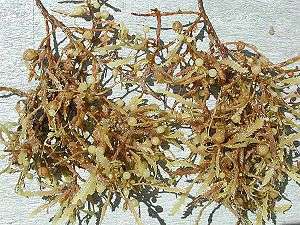Neritic zone
| Marine habitats |
|---|
 Sargassum seaweed drifting in the neritic zone provides food and shelter for small epipelagic fish. |
The neritic zone is the relatively shallow part of the ocean above the drop-off of the continental shelf, approximately 200 metres (660 ft) in depth.[1][2] From the point of view of marine biology it forms a relatively stable and well-illuminated environment for marine life, from plankton up to large fish and corals, while physical oceanography sees it as where the oceanic system interacts with the coast.
Definition (marine biology), context, extra terminology
In marine biology, the neritic zone, also called coastal waters, the coastal ocean or the sublittoral zone,[3] refers to that zone of the ocean where sunlight reaches the ocean floor, that is, where the water is never so deep as to take it out of the photic zone. It extends from the low tide mark to the edge of the continental shelf, with a relatively shallow depth extending to about 200 meters (110 fathoms or 667 feet). Above the neritic zone lie the intertidal (or eulittoral) and supralittoral zones; below it the continental slope begins, descending from the continental shelf to the abyssal plain and the pelagic zone.
Within the neritic, marine biologists also identify the following:
- The infralittoral zone is the algal dominated zone to maybe five metres below the low water mark.
- The circalittoral zone is the region beyond the infralittoral, which is dominated by sessile animals such as oysters.
- The subtidal zone is the region of the neritic zone which is below the intertidal zone, therefore never exposed to the atmosphere.
Physical characteristics
The neritic zone is permanently covered with generally well-oxygenated water, receives plenty of sunlight and has low water pressure; moreover, it has relatively stable temperature, pressure, light and salinity levels, making it suitable for photosynthetic life. In particular, the benthic zone (shallow ocean floor) in the neritic is much more stable than in the intertidal zone.
Life forms
The above characteristics make the neritic zone the location of the majority of sea life:[4] they result in high primary production by photosynthetic life such as phytoplankton and floating sargassum; zooplankton, free-floating creatures ranging from microscopic foraminiferans to small fish and shrimp, feed on the phytoplankton (and one another); both trophic levels in turn form the base of the food chain (or, more properly, web) that supports most of the world's great wild fisheries. Corals are also mostly found in the neritic zone, where they are more common than in the intertidal zone as they have less change to deal with.
Definition (physical oceanography)
In physical oceanography, the sublittoral zone refers to coastal regions with significant tidal flows and energy dissipation, including non-linear flows, internal waves, river outflows and ocean fronts. As in marine biology, this zone typically extends to the edge of the continental shelf.
See also
References
- ↑ anon. (n.d). Ocean Regions: Blue Water - Characteristics. Available: http://www.onr.navy.mil/focus/ocean/regions/bluewater1.htm. Last accessed 15 May 2014.
- ↑ Rizk, F. (n.d). MARINE ENVIRONMENT AND PRIMARY PRODUCTIVITY. Available: http://faculty.scf.edu/rizkf/OCE1001/OCEnotes/chap11.htm. Last accessed 15 May 2014.
- ↑ "Advanced Learner S Dictionary Botany". Retrieved 10 February 2016.
- ↑ Office of Naval Research